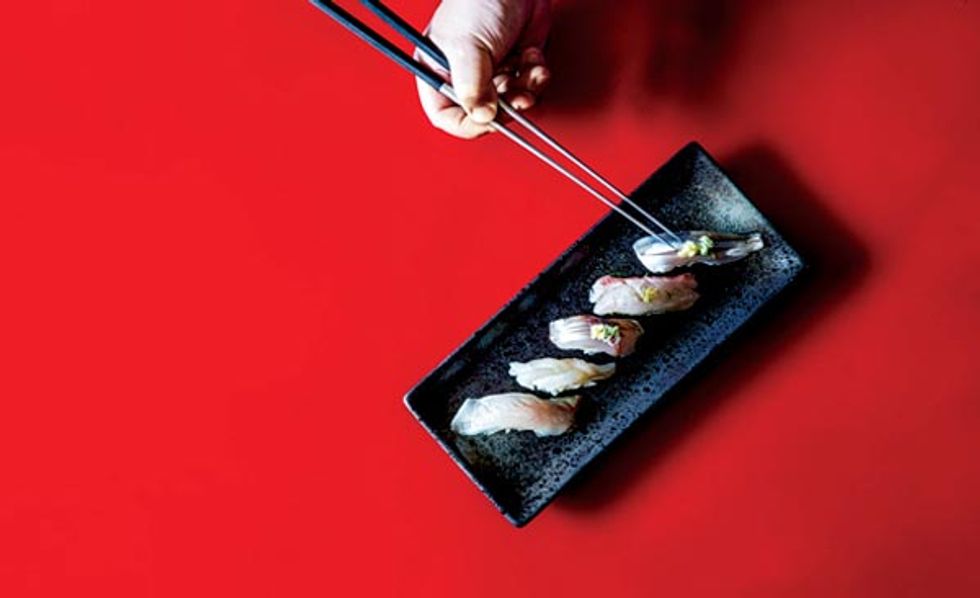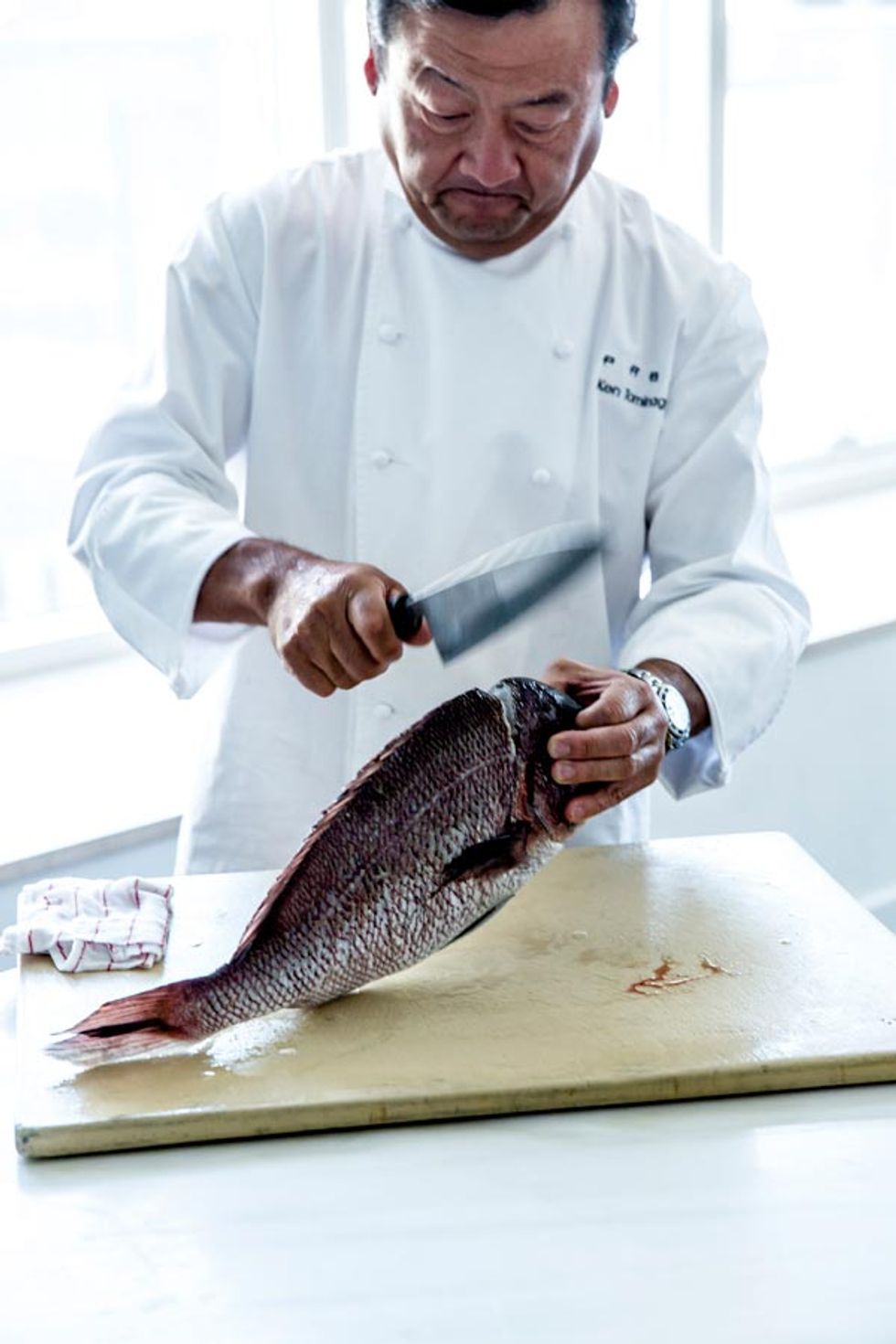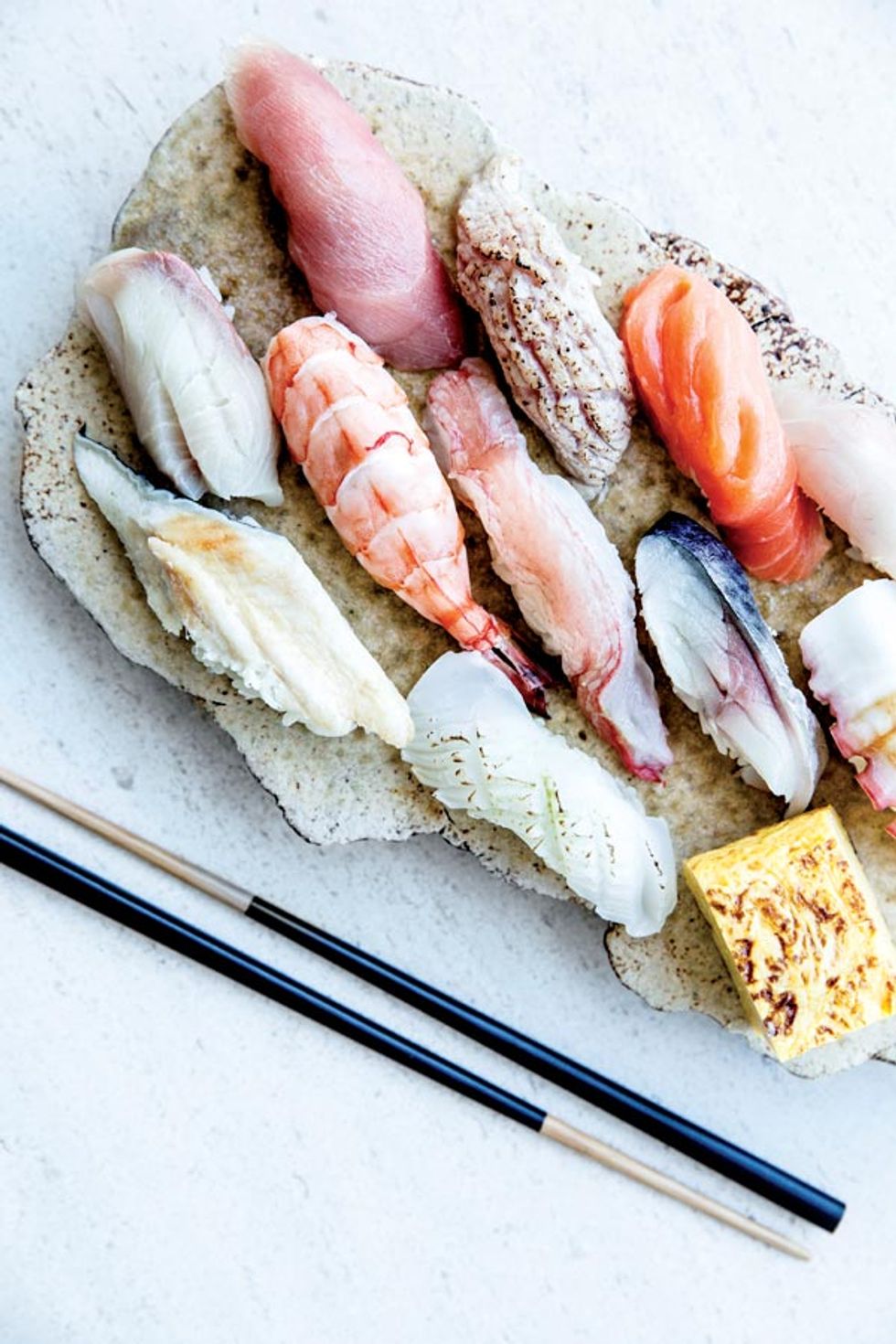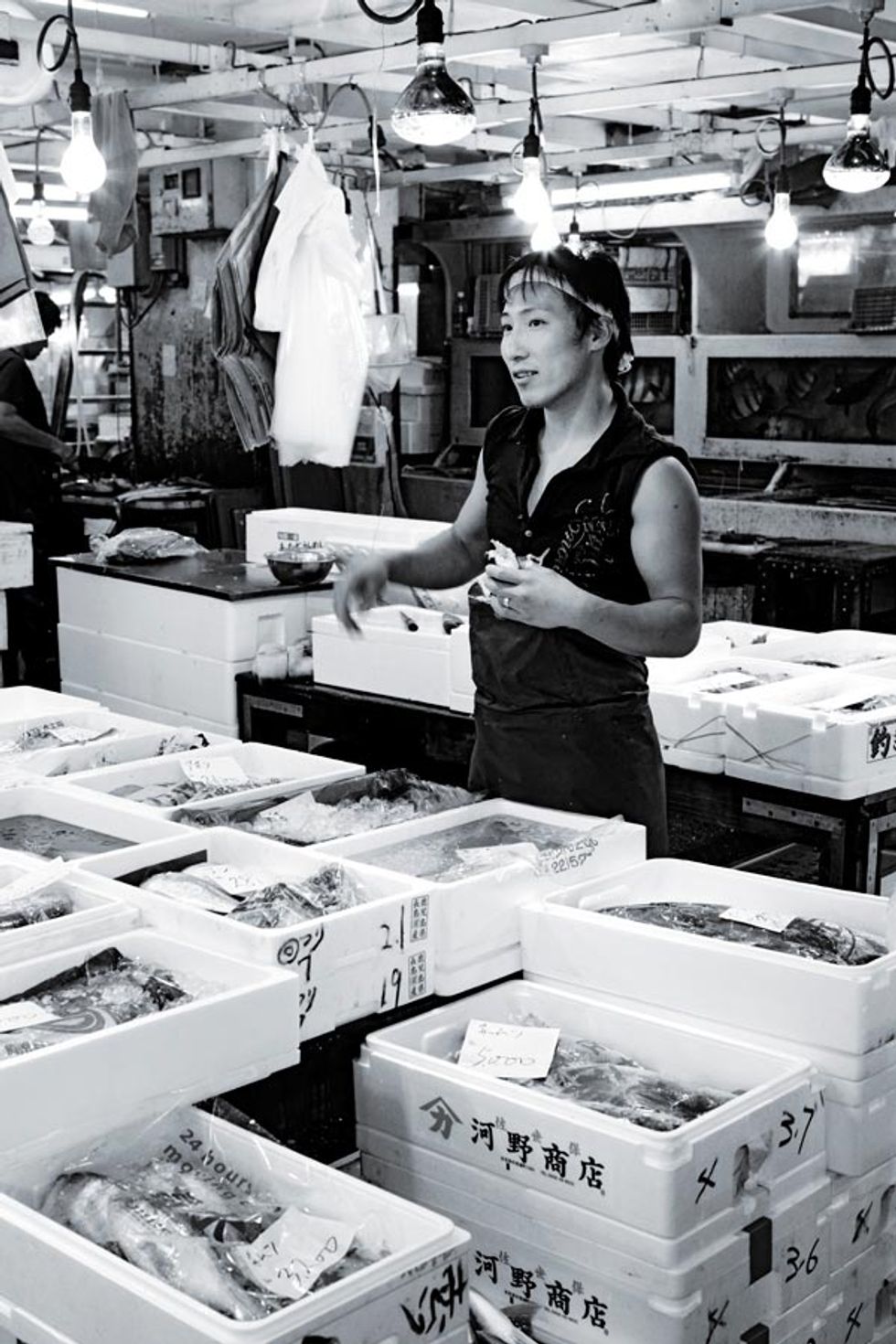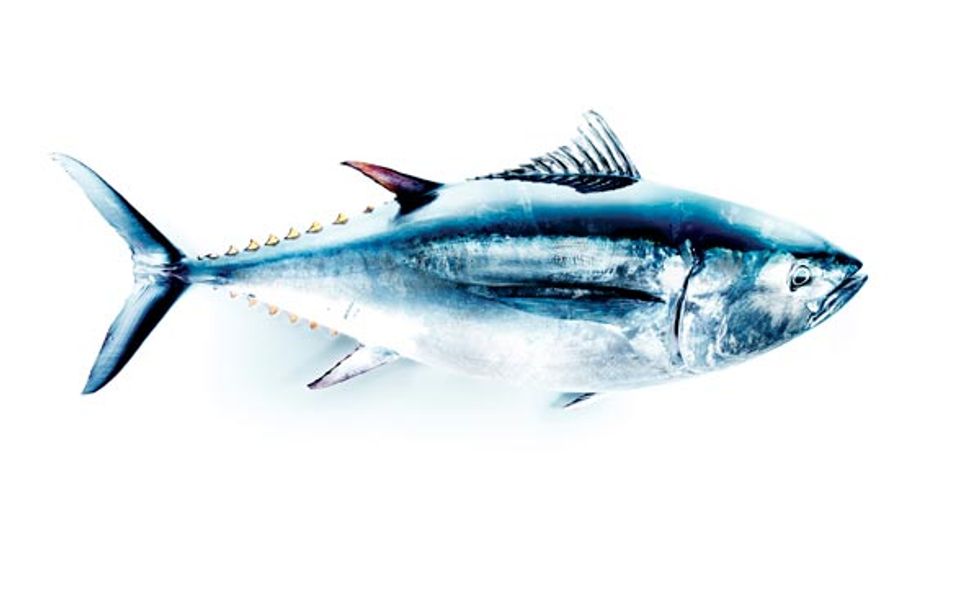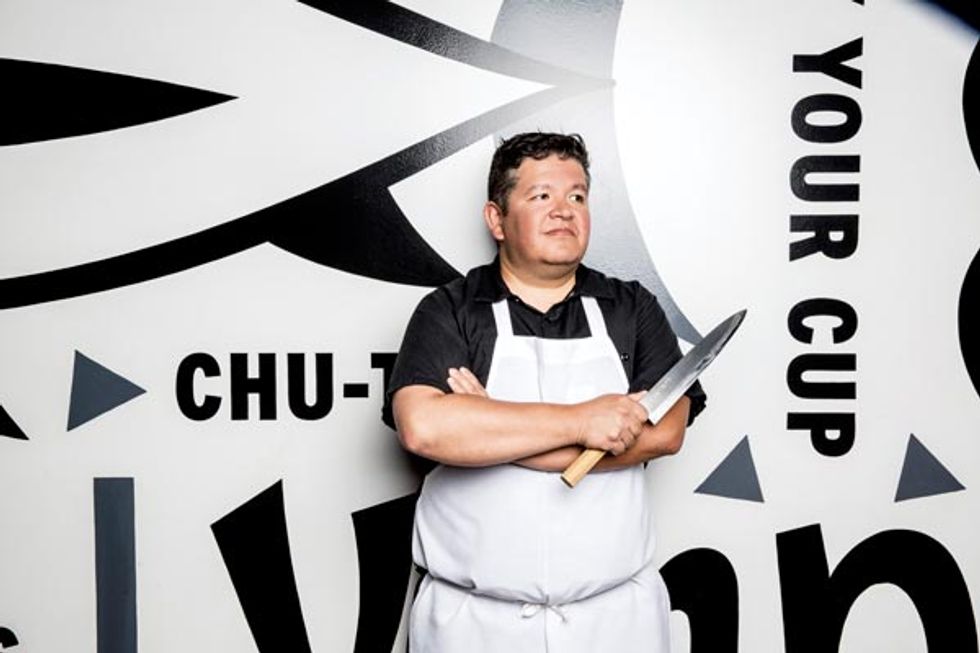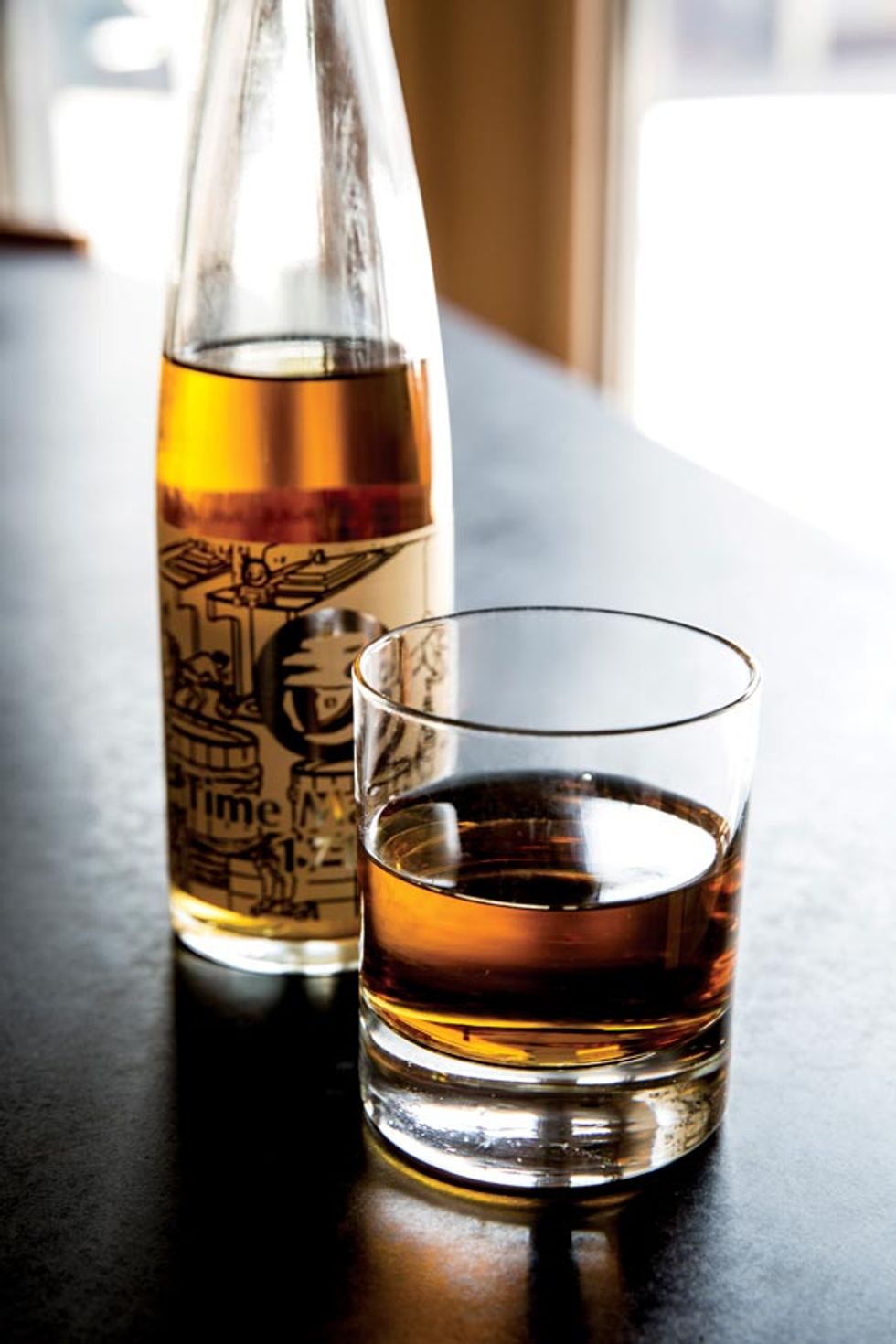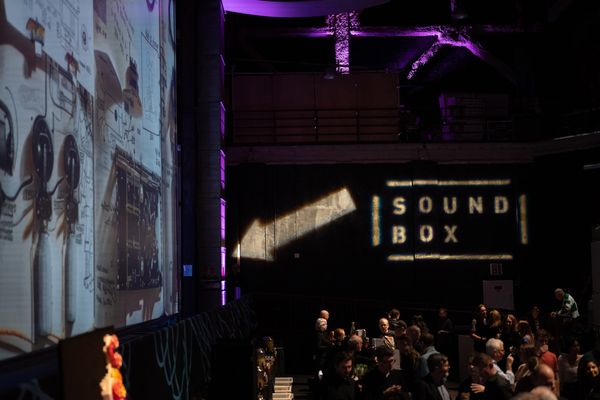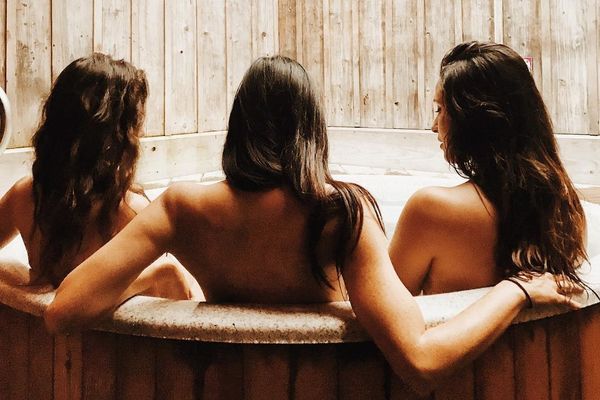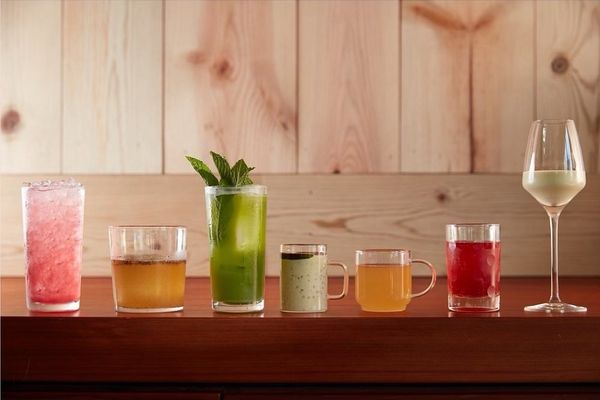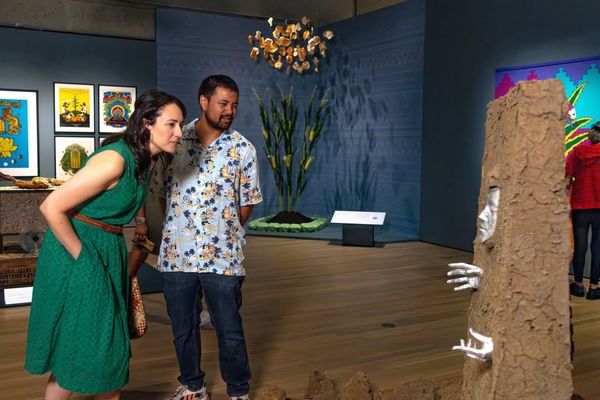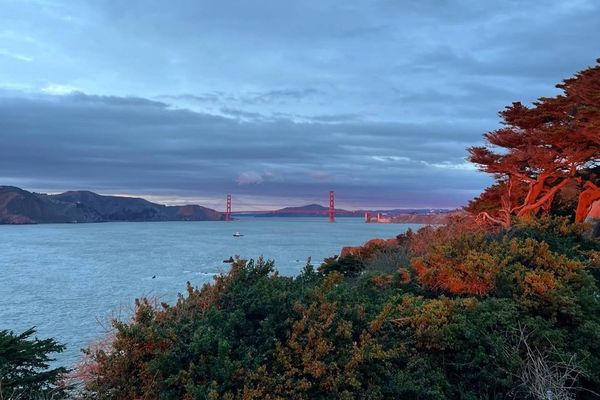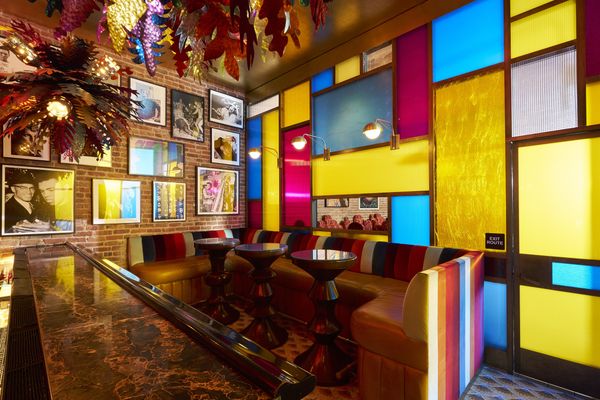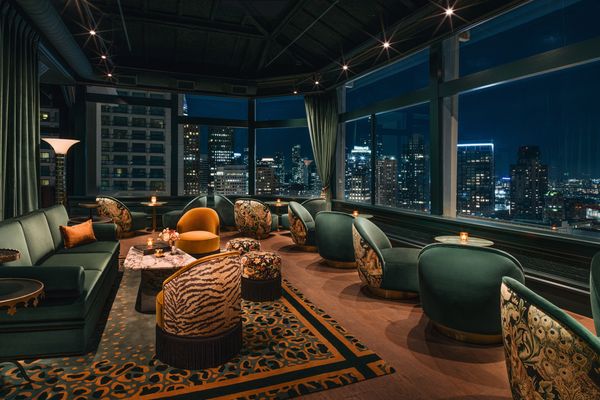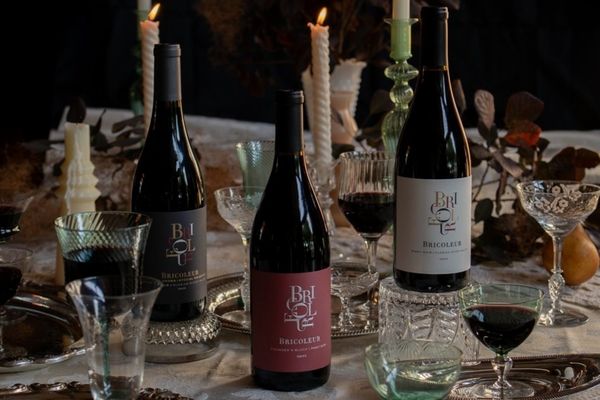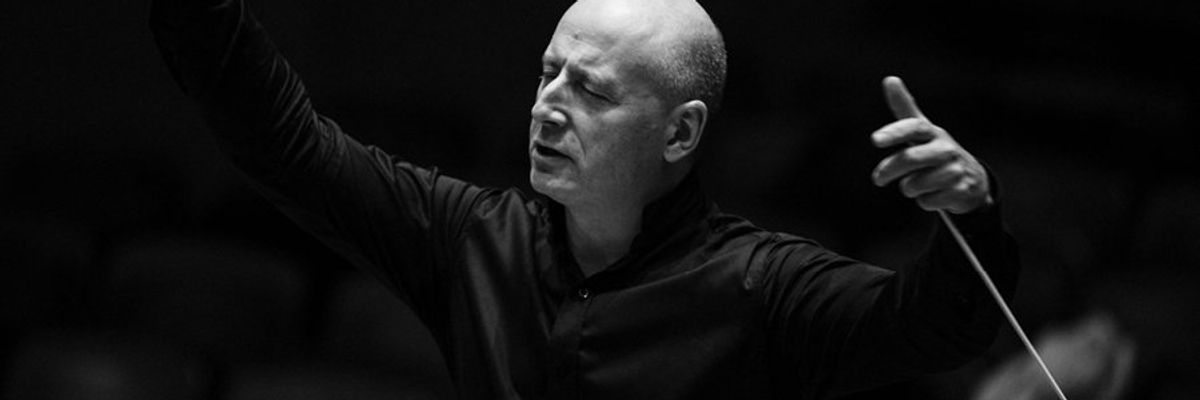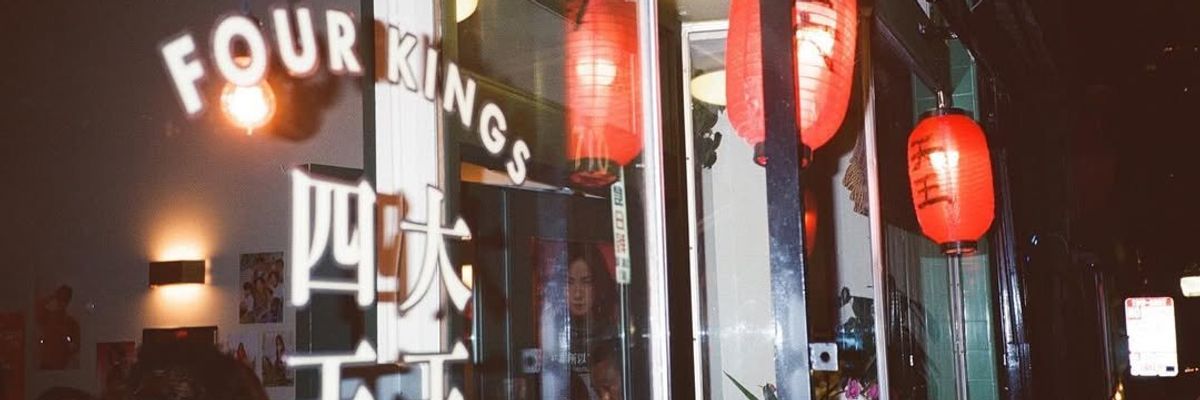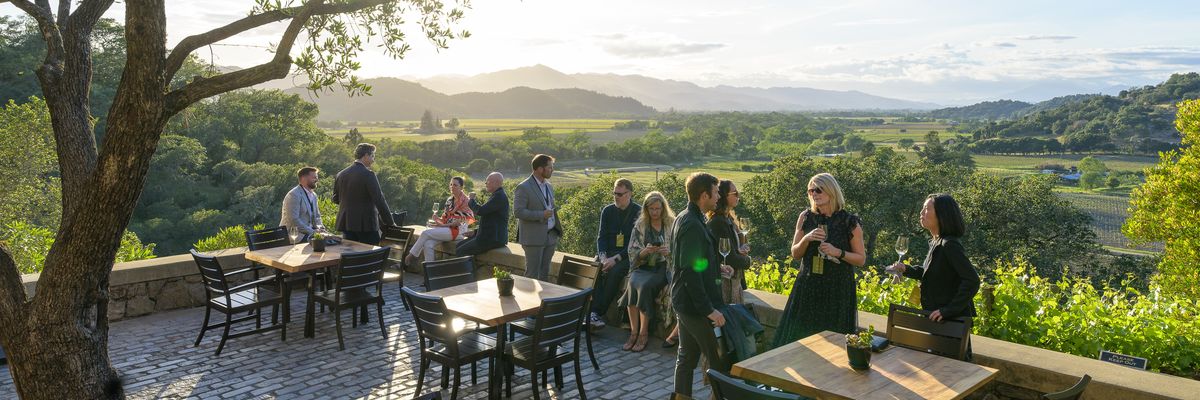Chef Ken Tominaga reaches over a refrigerated case stacked with pristine slabs of fresh fish and places a slice of raw sea bream, which is wrapped over a Brazil-nut-sized clump of sushi rice, onto a pretty ceramic plate. “No dipping,” he advises. This, I already knew. I became a fan of Tominaga’s sushi spot, Hana Japanese Restaurant, 14 years ago after Japanese chef Hiro Sone (of Ame and Napa’s Terra) clued me in. Hidden in a low-slung strip mall off the 101 in the Santa Rosa suburb of Rohnert Park, this was where he and his wife, Lissa, ventured when they craved one of Northern California’s most elusive culinary indulgences: good, authentic sushi.
Pabu chef Ken Tominaga tends to business--deftly readying madai (Japanese red sea bream), prized for its flavor, for the sushi counter.
Those who’ve experienced nigiri and sashimi in Japan, or even Los Angeles, have rightly complained that the Bay Area’s sushi culture—predominantly characterized by a short list of mostly frozen fish and Americanized specialty rolls—has left pretty much everything to be desired for decades. But Tominaga has been quietly dishing out masterful Edo-style interpretations at Hana since 1990.
It is here—and soon at Pabu (101 California Street ), his upcoming restaurant with chef-restaurateur Michael Mina in downtown San Francisco, which is slated to open next month—that, should you opt for omakase (chef’s choice), you will be regaled with Edo-style sushi the way the Japanese expect it: an edible exhibition of the chef’s ability to secure and expertly cut the best, freshest seafood and subtly enhance its natural flavors through a judicious use of culinary artistry. Each piece is carefully crafted into a one-bite portion so that you can experience the flavor of the fish and seasonings at once and in balance. Soy or other dipping sauces are rarely provided—the chef has seasoned your fish perfectly for you, perhaps through curing or a gentle brushing of house-made sauce, a sprinkle of green tea salt, a pinch of grated ginger, or a single drop of lemon juice. Even Tominaga’s soy sauce is refined to eliminate intense saltiness—it’s mixed with water and sake and gently simmered and cooled. Then there’s the rice; each chef has his or her own recipe, and in Japan, it’s universally known that you can judge a sushi restaurant by its rice (and its tamago, or egg omelet). Tominaga explains the thinking: “Ninety percent is the fish. Our contribution is the ten percent of adding flavor. We’re working very hard for that ten percent. If you don’t have good sushi rice, it doesn’t matter what you put on top.”
A gorgeous assortment of nigiri from Pabu.
Although Tominaga confesses that the American custom of uniformly dredging sashimi and nigiri in wasabi-spiked soy sauce upsets him, his gentle “no dipping” reminder underscores what’s made him so successful all these years, as well as what makes him perfectly poised to help broaden the horizons of sushi fans at Pabu. The Tokyo native, who briefly teamed with chef Cindy Pawlcyn in 2006 at Go Fish in St. Helena, attracts adventurous eaters with his expert knife, rice-making, and seasoning skills. Tominaga’s seafood—up to 30 varieties at any given time—is flown in fresh almost daily from Tokyo’s famed Tsukiji fish market and other parts of the world, seasoned with such thought and care that dousing it in soy sauce would be as wasteful as drenching a Kobe steak with ketchup. Yet he’s no Sushi Nazi—he happily satisfies novices with familiar rolls and a long list of delicious bento, noodle, and inventive cold and hot plates that echo Tokyo’s cooking styles and its emphasis on seasonal ingredients.
Seasonality is key for chef Tominaga, who often sources species such as katsuo (bonito) and ji saba (mackerel) from Tokyo’s Tsukiji fish market.
Pabu (“pub” in Japanese) will be Tominaga and Mina’s second outpost—like their first at The Four Seasons Baltimore, which opened in 2012, their 101 California Street location is designed to be a modern izakaya—and will be a casual after-work drinking and nibbling establishment, with a sushi bar. The design specs, which showcase a dramatic and airy cocktail area, traditional dining room, garden, sushi bar, and harbor-inspired ramen patio, loosely translate to a 300-seat answer to New York’s Tao—sexy and contemporary Japanese that’s firmly anchored in traditional design. A novella-like menu of small plates—Robata-grilled items, shabu shabu, ramen, donburi, salads, and bento boxes—will allow diners to get in and out without exploring Tominaga’s sushi-making talents, if that’s how they want to, ahem, roll. However, his multicourse omakase can be ordered anywhere in the dining room or at the sushi bar. The latter is the place to experience the city’s burgeoning version of Edo-style sushi, where tradition is honored through technique and ceremony but modernity is embraced through relaxed informality and a seafood selection that extends far beyond local offerings—or even Tokyo’s famed fish market. (Although Tsukiji has an astounding array of exotic seafood never found in our waters and, as of March, per the FDA, there is no evidence that Fukushima radiation is present in local or imported fish at levels that would pose a health concern, most of today’s top sushi establishments source from all over the world for the sake of quality and variety.)
Toro, or bluefin tuna, is prized in sushi circles for its rich flavor and buttery texture—tragically, it’s also overfished. With populations at near collapse worldwide, chef Tominaga and his teams at both Hana and Pabu, who support sustainable fishing practices whenever possible, opt for using Japanese farm-raised bluefin rather than million-dollar line-caught specimens sold at auction. If your moral compass points to no, whatever the source, Monterey Bay Aquarium’s Seafood Watch program suggests opting for albacore instead—and informing chefs of your preference for sustainable fish sources.
Pabu is just one of a generous handful of new sushi restaurants opened in the past few months that are taking prevailing perceptions to task with serious, traditional Japanese ambitions, tempered by atmospheres that are friendlier and more relaxed than formal Tokyo sushi shrines. Although Bernal Heights’ Ichi Sushi, a beloved neighborhood hole-in-the-wall by chef-owner Tim Archuleta and his wife-partner Erin, was a rare source of pristine sushi until 2010, it’s their reincarnation as izakaya Ichi Sushi + Ni Bar (3282 Mission Street), which opened in February, that’s bringing their seasonal, sustainable, top-notch seafood and cooked dishes to the masses (including the youth—they’ve got a ’90s hip-hop soundtrack on lock). The Archuletas and sushi chef de cuisine Erik Aplin eschew the flavor-annihilating wasabi–and–soy sauce culture, evidenced by a giant cheeky mural, opposite the sushi counter, offering tips on how to eat sashimi the Japanese way: For example, grab it with clean fingers and dip it, when sauce is provided, fish-side down. Despite a recent encounter with a diner who was enraged that his soy sauce demand was denied and who bellowed some choice words at the staff before storming out, the presentation to customers of expertly seasoned nigiri and cooked specialties has generally been more than well received.
Ichi Sushi + Ni Bar chef Tim Archuleta puts on a rare serious face (he’s typically all smiles) in front of the restaurant’s how-to mural by local letterist Erik Marinovich.
Nearby in the Mission, 25-seat Maruya, which opened in October, is yet another opportunity for a more authentic taste of Japan. Backed by peppy jazz, chef-partner Masa Sasaki works the way Tokyo masters do, quietly and methodically gliding his knife through fat pieces of big eye tuna, scoring and lightly saucing Japanese trout, torching Spanish toro with focus and precision, and shaping his beautiful cuts of fish into photo-worthy presentations as diners at his traditionally designed L-shaped cypress bar look on lustfully. (He keeps his fish in small stainless steel briefcases, which are stored under the counter, affording bar diners unobstructed views of his work.) The omakase-only menus, available at the tables, start at $40 for 10 pieces of sushi, but you’ll pay $85 to sit at the bar and enjoy the full omakase experience, complete with a parade of cooked embellishments from the kitchen, artistically presented.
In media, they say three makes a trend. Newly opened Kusakabe (584 Washington Street), which debuted in the Financial District in May, suggests the SF sushi movement is more than that. This is the first foray into the city for chef Mitsunori “Nori” Kusakabe, though he comes with plenty of fanfare, thanks to his nearly 10 award-winning years as the sushi chef at Sausalito’s Sushi Ran. At his elegant 30-seat restaurant with a locally sourced, solid elm sushi bar, the omakase menu gives a nod to Japan’s highly artistic kaiseki cuisine, which is derived from Japanese tea ceremony traditions and artfully integrates seasonal colors, tastes, senses, and cooking methods into a sophisticated multicourse meal.
Part the traditional Japanese curtains outside any of these new restaurants and enter into SF’s contemporary world-class food culture, Edo style. When you forgo the cream-cheese-and-imitation-crab sushi scene that’s dominated Japanese dining in the city since the ’80s, you’ll pay more for the experience—in many cases, a lot more. But on the bright side, it’s still a heck of a lot cheaper than hopping a flight and dining in Tokyo, where tonight they’ll be eating the very same fish flown here today. It’s about time our sushi dreams came true.
SAKE TO ME
Sake is finally getting its due as bar managers and sake sommeliers curate enviable lists. Ready for your sake education? Start with three of our favorite programs around town. - Lauren Sloss
Beginner:
Ichi Sushi + Ni Bar
Bar Manager Ken Furusawa is the perfect person to help you develop your sake palate. He selects around 15 sakes per season (including rare bottles), featuring a variety of styles, flavors, and alcohol content.
Pair It:
Kura no Hana Daiginjo with sashimi
Intermediate:
Roka Akor
Don’t be intimidated by an extensive sake menu. At Roka Akor, General Manager Jason Reiplinger has divided the restaurant’s list of 50-something sakes into four flavor-driven categories: Kire, Kaori, Aji, and Asobe. Let your server know what type of food you’re craving, and he or she will direct you to the appropriate sake section.
Pair It:
Dewatsuru Kimoto (J) Akita with Robata grilled pork belly
Expert:
Pabu
Get your credentials in sake know-how at Pabu come July, with Stuart Morris as your guide. The certified sake sommelier will help you navigate the 50-plus sake menu—pick your pleasure based on your meal, the sake’s flavor profile, or the sake’s region of origin.
Pair It:
Gunma Izumi Chotoku Junmai with yakitori
Kanpai! Get more master advice and sake tips with a primer here.



